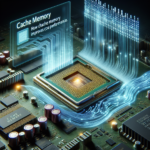How CPU Cores and Threads Work Together

Introduction to CPU Cores and Threads
In the realm of computing, the Central Processing Unit (CPU) is often referred to as the brain of the computer. It performs the essential task of executing instructions from programs, making it a critical component in any computing device. However, the efficiency and speed at which a CPU can perform these tasks depend significantly on its architecture, particularly its cores and threads. This article delves into how CPU cores and threads work together to enhance computing performance, providing a comprehensive understanding of their roles and interactions.
Understanding CPU Cores
What is a CPU Core?
A CPU core is an individual processing unit within the CPU. Each core can independently execute instructions, allowing for multitasking and parallel processing. Modern CPUs often come with multiple cores, ranging from dual-core (2 cores) to octa-core (8 cores) and beyond. The more cores a CPU has, the more tasks it can handle simultaneously, leading to improved performance, especially in multi-threaded applications.
How CPU Cores Work
Each core in a CPU operates like a mini-processor. It fetches instructions from the system’s memory, decodes them, executes them, and then writes back the results. This process is known as the instruction cycle. By having multiple cores, a CPU can perform multiple instruction cycles concurrently, significantly boosting its processing power.
Understanding CPU Threads
What is a CPU Thread?
A CPU thread is a sequence of programmed instructions that the CPU can execute. In the context of multi-threading, a single core can handle multiple threads by rapidly switching between them, giving the illusion of parallelism. This is known as simultaneous multithreading (SMT) or hyper-threading in Intel CPUs.
How CPU Threads Work
Threads are the smallest unit of processing that can be scheduled by an operating system. When a CPU core supports multiple threads, it can switch between them so quickly that it appears to be executing them simultaneously. This capability allows for better utilization of the CPU’s resources, reducing idle time and increasing overall efficiency.
The Synergy Between CPU Cores and Threads
Parallel Processing
Parallel processing is the simultaneous execution of multiple tasks. With multiple cores and threads, a CPU can divide a large task into smaller sub-tasks and process them concurrently. This approach significantly reduces the time required to complete complex computations, making it ideal for applications like video rendering, scientific simulations, and large-scale data analysis.
Multitasking
Multitasking refers to the ability of a CPU to handle multiple tasks at the same time. With multiple cores and threads, a CPU can run several applications simultaneously without significant performance degradation. For instance, you can browse the internet, listen to music, and run a virus scan all at once, thanks to the multitasking capabilities enabled by multiple cores and threads.
Load Balancing
Load balancing is the distribution of workloads across multiple cores and threads to ensure that no single core is overwhelmed. Modern operating systems and applications are designed to distribute tasks evenly, optimizing CPU usage and preventing bottlenecks. This balanced approach enhances system stability and performance.
Real-World Applications
Gaming
Modern video games are highly demanding in terms of processing power. They require real-time rendering of complex graphics, physics calculations, and AI processing. Multi-core, multi-threaded CPUs can handle these tasks more efficiently, providing smoother gameplay and better frame rates.
Content Creation
Tasks like video editing, 3D rendering, and graphic design are computationally intensive. Multi-core CPUs can significantly speed up these processes by dividing the workload across multiple cores and threads. This capability allows content creators to work more efficiently and meet tight deadlines.
Scientific Computing
Scientific research often involves complex simulations and data analysis. Multi-core, multi-threaded CPUs can perform these tasks more quickly, enabling researchers to process large datasets and run simulations in a fraction of the time it would take with a single-core CPU.
Technological Advancements
Hyper-Threading
Hyper-threading is a technology developed by Intel that allows a single CPU core to handle two threads simultaneously. This technology effectively doubles the number of threads a CPU can handle, improving performance in multi-threaded applications. However, it’s important to note that hyper-threading does not double the performance, as the two threads still share the same core resources.
AMD’s Simultaneous Multithreading (SMT)
Similar to Intel’s hyper-threading, AMD’s simultaneous multithreading (SMT) allows each core to handle two threads simultaneously. This technology enhances the efficiency of AMD CPUs, making them competitive with Intel’s offerings in multi-threaded performance.
Future Trends
The future of CPU technology is likely to see an increase in the number of cores and threads, along with advancements in parallel processing and AI integration. These developments will further enhance the capabilities of CPUs, enabling them to handle even more complex tasks with greater efficiency.
FAQ
What is the difference between a core and a thread?
A core is a physical processing unit within a CPU, capable of executing instructions independently. A thread, on the other hand, is a sequence of instructions that can be managed by a core. Multiple threads can run on a single core through techniques like hyper-threading or simultaneous multithreading.
How do more cores and threads improve performance?
More cores and threads allow a CPU to handle multiple tasks simultaneously, improving multitasking and parallel processing capabilities. This leads to faster execution of complex tasks and better overall system performance.
Is hyper-threading the same as having more cores?
No, hyper-threading allows a single core to handle two threads simultaneously, effectively doubling the number of threads a CPU can manage. However, it does not double the performance, as the two threads share the same core resources. More cores provide additional physical processing units, which generally offer better performance improvements than hyper-threading alone.
Do all applications benefit from multiple cores and threads?
No, not all applications are designed to take advantage of multiple cores and threads. Single-threaded applications will not see significant performance improvements from additional cores or threads. However, multi-threaded applications, such as video editing software and modern video games, can benefit greatly from a multi-core, multi-threaded CPU.
How can I check how many cores and threads my CPU has?
You can check the number of cores and threads your CPU has through your operating system’s system information utility. On Windows, you can use the Task Manager or System Information tool. On macOS, you can use the “About This Mac” option. Additionally, you can refer to the CPU specifications provided by the manufacturer.
Conclusion
Understanding how CPU cores and threads work together is crucial for appreciating the advancements in modern computing. Multiple cores and threads enable parallel processing, multitasking, and load balancing, significantly enhancing the performance and efficiency of CPUs. As technology continues to evolve, we can expect even more powerful CPUs capable of handling increasingly complex tasks. Whether you’re a gamer, content creator, or researcher, the synergy between CPU cores and threads plays a vital role in delivering the performance you need.




